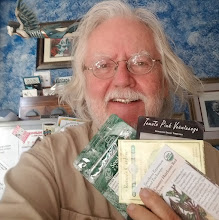 Garlic in my garden, planted in October, doesn't really need a sign to tell us what they are, but the sign blends right in with our rustic style.
Garlic in my garden, planted in October, doesn't really need a sign to tell us what they are, but the sign blends right in with our rustic style.It’s a bit late, but I finally got around to cleaning up last year’s garlic harvest. It’s a jumble, but there are three varieties of garlic in the bag and not a one of them is available at any local supermarket, although a fortunate soul may find them at a farmers’ market from someone who specializes in garlic. These are hard neck garlics and are not favored in the mass-production/consumption world for several reasons, none of which should deter the home gardener from planting them with abandon.
Hard neck garlic has a reputation of being harder to grow than the more common soft neck garlic. I have not found this to be true. They have grown fine for me in every garden I’ve grown them (three, since I stated this journey) and the payoff in flavor makes any additional difficulty well worth any extra effort.
The main reason supermarkets give for avoiding the hard neck garlic (Allium sativum var. ophioscorodon) though is the fact that they do not keep as well as soft neck garlic (Allium sativum var. sativum). The ‘soft neck’ collapses at the top of the garlic bulb sealing in the flavor and keeping the moisture level perfect for long storage. In addition, the soft neck garlic has more wrapping layers and so are a lot less inclined to spoil while in transit or waiting to be sold, the main consideration of our food marketing system in the US. Flavor is not a factor in the decision-making process for the providers of the American diet and the supermarket garlic is almost always ‘California Early’ or ‘California Late,’ reliable producers, reliable keepers; just lame on real garlicky flavor.
Hard neck garlic, to my taste buds, is as different to the common garlic as a fine cabernet (with a date, no less!) is to a box of red wine. Some of the garlic one can find in this category include: Chesnok Red, Spanish Roja, Killarney Red and Romanian Red, all with a robust flavor that puts the supermarket garlic to shame.
We can still plant garlic here in Southern California gardens, although prime planting time is usually from late September to late November. My garlic is up about ten inches, right now, but with our moderate climate, garlic planted even this late will still provide a lovely harvest – once you’ve gotten towards planting in January though, the bulbs wont’ have time to size up nicely before July/August’s heat and lack of water. Garlic is usually ready to pull in late May and June.
It is easy to plant and to grow.
The garlic bulb is broken into the individual cloves which are then planted pointy end up (you can tell the blunt end is the end where roots were once attached and the pointy end is the end with the leaves), about six inches apart. They are pushed into the ground only as deep as the clove – if some of the clove is still sticking above ground, that’s ok. I know most books (and websites) would have you plant them much deeper, but they are helping you avoid frost damage. Los Angeles hasn’t had a frost in ages so it is not necessary to plant our garlic that deep (it’s also why you can still plant garlic this late in the season!). Garlic does not need a lot of water, but if we have no rain, water it like you would most vegetables, or a little less.
Garlic’s only problematic feature is that it must be allowed to dry out before harvesting – in fact, water should be withheld in the last month or so before pulling the garlic so that it begins to form reasonable wrapping layers that allow it to store. If it is planted near plants that will continue to need water through May and June, this can be hard on those plants or the garlic – you choose.
Garlic can be pulled without the benefit of drying out in the soil, but this does not promote long term storage and hard neck garlic is not well inclined towards long term storage under the best of conditions, so plan on eating your garlic sooner rather than later. That isn’t necessarily a problem for eating it, but it makes saving bulbs for next year’s planting a game of chance.
You can purchase garlic at an organic market (just to make certain its not been treated with something to inhibit sprouting) and plant that, but why bother? It probably won’t be as flavorful of a garlic as one where you buy a named variety as noted above, and if something is available locally there is less incentive to grow it yourself.
Finding seed garlic can be hard at this time of the season, but a quick check on the web will net you some folks with garlic still to sell. If you haven’t done so yet, do it now and you’ll be very pleased with the result.
‘Gourmet’ is within your reach!
david






.jpg)
1 comment:
Thanks for the info! I'll have to plant some garlic next year.
Post a Comment